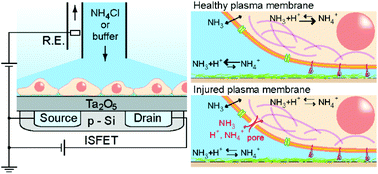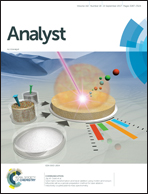Identification of types of membrane injuries and cell death using whole cell-based proton-sensitive field-effect transistor systems†
Abstract
An NH4Cl-superfused system for a cell-cultured pH-sensing transistor was developed for detecting ion leakage across the plasma membranes of model HepG2 cells. The screening of chemical species by the method developed and conventional membrane-leakage assays identified the types of membrane injuries: structural membrane disruption and pore formation. Apoptosis-mediated membrane disordering was detected by continuously monitoring the ion-barrier breakdown of the membranes using the transistor system for an extended period. Comparisons of the ISFET assay with conventional cytotoxicity assays distinguished the cell death by direct membrane injury from that by other organelle damage. Our cell-based transistor system is fast and sensitive to ion leakage of the plasma membrane due to the small hydrodynamic size of the proton and ammonium ions as the indicators. The combination of the ion leakage assay with the existing cytotoxicity assays is a new way of classifying membrane injury and cell death induced by external chemical stimuli.



 Please wait while we load your content...
Please wait while we load your content...